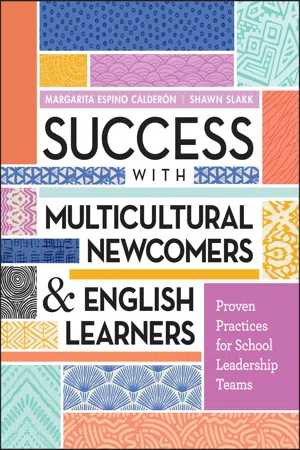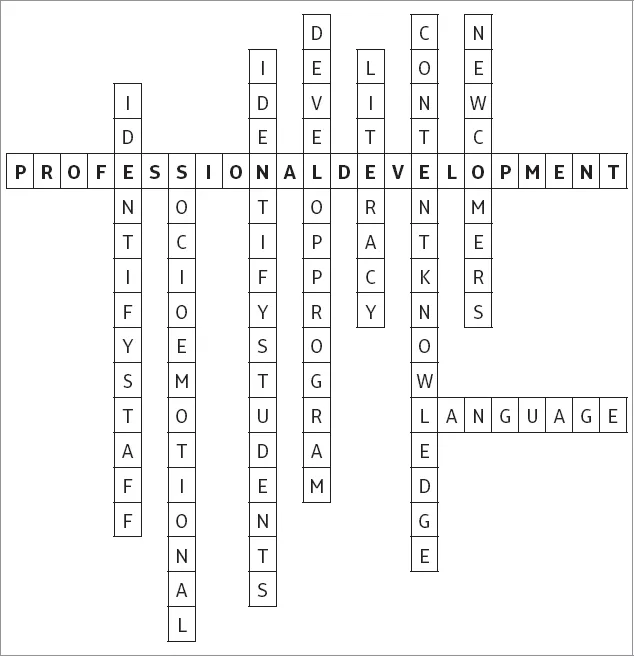
Success with Multicultural Newcomers & English Learners
Proven Practices for School Leadership Teams
- 140 pages
- English
- ePUB (mobile friendly)
- Available on iOS & Android
Success with Multicultural Newcomers & English Learners
Proven Practices for School Leadership Teams
About this book
This book is a road map for teachers and school leaders who need to meet the needs of increasing numbers of Newcomers and other English Learners (ELs). The authors draw from years of experience in working with, listening to, and coaching administrators, teachers, and coaches nationwide to help you develop and implement an effective plan for your school.
Beginning with the core belief that "getting to know the student is pivotal, " the authors show how to address both the academic and the social needs of Newcomers to help them integrate and excel—from their first day of school. The main components of the plan are the following: - Identifying your students and assessing educational and socioemotional needs.
- Identifying qualified teachers and staff.
- Developing highly effective programs for Newcomers and other ELs.
- Accelerating English learners' acquisition of language, literacy, and knowledge through proven classroom teaching techniques.
- Supporting Newcomers' socioemotional well-being through classroom and administrative structures.
- Designing, implementing, and sustaining professional development for all staff.
If you already have a plan for integrating Newcomers and ELs, you can use the information in this book to assess and strengthen it and to learn more about resources for continued coaching and growth. Whether your school has a formal plan or not, the information in this practical guide can help your staff better collaborate to attend to the needs and build on the strengths of Newcomers and ELs in your school.
Frequently asked questions
- Essential is ideal for learners and professionals who enjoy exploring a wide range of subjects. Access the Essential Library with 800,000+ trusted titles and best-sellers across business, personal growth, and the humanities. Includes unlimited reading time and Standard Read Aloud voice.
- Complete: Perfect for advanced learners and researchers needing full, unrestricted access. Unlock 1.4M+ books across hundreds of subjects, including academic and specialized titles. The Complete Plan also includes advanced features like Premium Read Aloud and Research Assistant.
Please note we cannot support devices running on iOS 13 and Android 7 or earlier. Learn more about using the app.
Information
Identifying and Getting to Know the Newcomers and Other English Learners in Your School
The Organization of This Book
Professional Development Program: Key Components
- Identifying your students
- Identifying your qualified teachers and staff
- Developing a programmatic structure of service
- Accelerating ELs' language, literacy, and knowledge base
- Supporting Newcomers' socioemotional well-being
- Designing, implementing, and sustaining professional development for all staff
Figure 1.1. Key Components of Professional Development Program

Who Are Your Newcomers?
Figure 1.2. 2nd to 12th Grade Newcomers: Language and Literacy in First Languages Continuum
No schooling
New to print
Need alphabet, phonics, sound to letter concepts, concept of word, basal beginning word/vocabulary study, reading and orthographic/writing skills
Need language for socioemotional expression and survival in school and community
Missing 2+ years of elementary or secondary level
Some L1 literacy
Need advanced phonics, long/short vowels, syllables and affixes, concept of words in text, grammar and mechanics, vocabulary, basic reading and writing
Need language for socioemotional expression and survival in school and community
Missing 1–2 years of elementary level
Elementary level L1 literacy
Need elementary word/vocabulary study, reading comprehension skills, and text-based writing
Need language for socioemotional expression and survival in school and community
Missing 1–2 years of secondary level
Some L1 reading skills but limited writing
Need secondary advanced content words, more vocabulary study, multiple genre reading comprehension skills, and text-based writing
Need language for socioemotional expression and survival in school and community
Significant schooling
Grade level L1 reading and writing skills
Need vocabulary labels for known concepts, reading comprehension, and text-based writing skills
Need language for socioemotional expression and survival in school and community
Classification of Newcomers and Other ELs
- Refugees. These students are from places made inhospitable by severe violence and war. Refugee parents can apply for U.S. permanent resident status after one year from legal entry and then may request U.S. citizenship after five years. When refugees arrive, they are placed near private resettlement agencies that assist them with housing and job placement.
- Non-Refugee Newcomers. These are students from, for example, Mexico, India, China, and Cuba, as well as well as students displaced by natural disasters (who are ineligible for refugee status). They may not possess the U.S. residency permits necessary for them to receive governmental aid. NoteStudents from Puerto Rico, though U.S. citizens, are sometimes classified as non-refugee Newcomers as, due to their educational system's "Spanish as the official language" policy and newness to English, their English proficiency is limited.
- Highly Schooled Newcomers (HSN). These students are children of government officials, professionals, and other highly schooled immigrants from all over the world, with the highest numbers from India. These students may speak great English but may need cultural and pronunciation assistance. Even those from countries where English is a national language—Liberia, South Africa, Singapore—might have gaps in dialect, reading comprehension skills that meet state standards, and cultural adaptation.
- Students with Limited or Interrupted Formal Education (SLIFE)/Students with Interrupted Formal Education (SIFE). These students arrive in 2nd to 12th grades with little or no education experiences in their previous countries (see Figure 1.2 for more details). Their language, literacy, and content knowledge may also be limited in their primary languages. Hence, they may need basic decoding skills and emergent writing skills, along with abundant vocabulary.
- Dually Identified Newcomers. These students also need to be considered for special education services. They must be assessed 30 days after arriving, per the Every Student Succeeds Act guidelines, and receive both English as a Second Language/English Language Development (ESL/ELD) and special education services.
Other EL Students New to Your School
- Migrant ELs. These are students who are most likely born here and thus could fit in several categories of ELs or non-ELs. Migrant students travel with their parents from state to state following the crops or other temporary job opportunities. State Migrant Education offices typically have records of their schooling from the various places in which they have resided.
- Long-Term ELs (LTELs). These are students who are most likely U.S. citizens, perhaps second- or third-generation, and have had U.S. EL status for at least five years. They, unfortunately, did not receive quality instruction. The U.S. Department of Education publications state that 70 percent or more of all students categorized as ELs are LTELs.
- Dreamers. These are undocumented students who were brought here by their parents. They constantly fear deportation. They often work and study relentlessly and are on track to attend college.
- Standard English Learners (SELs). California uses this term for students who were never classified as ELs but who speak nonstandard forms of English (e.g., Chicano English or African American vernacular English) and have academic linguistic needs. The dialects and language that they bring to school should be built upon and not viewed as a deficit (Soto-Hinman & Hertzel, 2009).
Table of contents
- Cover
- Title Page
- Table of Contents
- Chapter 1. Identifying, Getting to Know, and Assessing the Newcomers and Other English Language Learners in Your School
- Chapter 2. Assessing Academic Needs and Placing in EL Programs
- Chapter 3. Understanding Social and Emotional Needs
- Chapter 4. Staffing the Programs and Professional Development
- Chapter 5. Schoolwide Programs
- Chapter 6. Teaching Vocabulary and Discourse
- Chapter 7. Teaching Reading Comprehension
- Chapter 8. Teaching Writing
- Conclusion
- Appendix
- Bibliography
- Study Guide
- Related ASCD Resources
- About the Authors
- Copyright